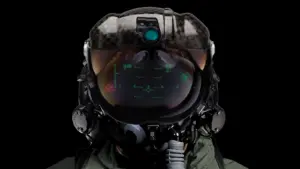The U.S. Navy’s Naval Air Systems Command placed an order worth $347.4 million with Lockheed Martin for a specialized helmet for pilots of the F-35 fighter jet. The advanced helmet is produced by a collaboration between two companies: Collins Aerospace (based in Cedar Rapids, Iowa) and Elbit Systems of America (located in Fort Worth, Texas).

Unlike traditional fighter jets that have a head-up display (HUD) showing critical flight information on a screen in front of the pilot, the F-35 uses this helmet as its main display. According to a report in Military+Aerospace Electronics, the helmet combines a standard HUD, helmet-mounted display, and night vision, projected directly onto the visor. The F-35 jet has six infrared cameras around it. Their feed is streamed to the pilot’s helmet in real-time, allowing pilots to see in all directions, including through the plane’s structure. It allows pilots to virtually “see through” the plane’s bottom or directly at a target, giving them a full view of the surroundings, even below the aircraft. This is especially crucial for targeting and maintaining awareness. Each helmet is uniquely crafted to fit each pilot using 3D milling. It also tracks where the pilot looks, so they can aim weapons just by looking at a target.
For nighttime operations, the helmet projects visuals directly onto its visor, making separate night-vision goggles unnecessary. The pilot can target weapons simply by looking at a desired target and can also receive cues and data directly on the helmet’s display.
During its development, engineers shifted the helmet’s display technology from LCD to OLED to address a visual issue called optical blooming, especially during nighttime carrier landings. When a particular pixel or set of pixels on an LCD gets overwhelmed by too much light, it can spill over to adjacent pixels, causing them to also become saturated. This results in bright spots in the image appearing to spread or bloom beyond their actual boundaries.
Lockheed Martin, responsible for executing the order, is expected to finish the work by December 2026. Among the features of the HUD helmets are:
- Field of view: 40H x 30V degree; with 100% overlap
- Accuracy: <2 mr rms • Active noise reduction (ANR)
- Compatible with eyeglasses and laser eye protection (LEP) devices
- Ejection capability to 550 KEAS • Video recording
- Custom helmet liner for precise fit and comfort
- Supports multiple video inputs
- Multiple interpupillary distance (IPD) settings

